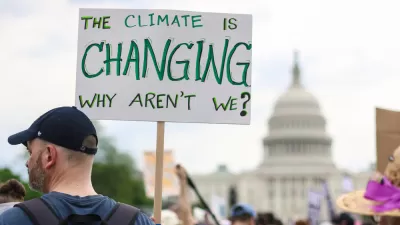McKay Jenkins looks at the challenges confronting Maryland as the state tries to reckon with the devastating consequences of the era of sprawl and prepare for an additional one million people over the next twenty five years.
With the state's natural and man-made systems stretched to their breaking point, Jenkins speaks with Rich Hall, Maryland's director of planning, who has the unenviable task of figuring out how to manage the need to accommodate 500,000 new homes in the next two and a half decades.
While a thoughtful new document called PlanMaryland lays out a sustainable growth vision for the state, already the fifth-most densely populated in the country, it has no legally binding language and poses a tough question for the area's residents and politicians, writes Jenkins: "What makes a state a good place to live, not just today but for a long time? Because when it comes right down to it, Maryland can grow like an oak, using its resources wisely and well, staying within its natural limits. Or it can grow like a cancer."
In a thorough piece, Jenkins looks at the key challenges the state is facing around such issues as housing ("how to induce people and businesses to move back to cities and towns"); protecting farms and forests ("From 1982 to 2007...state farmers sold some 500,000 acres of land-one-fifth of Maryland's total-to developers); and transportation ("The state's average commute time is now nearly thirty-two minutes, longer than both New York and New Jersey and one of the highest numbers in the country).
FULL STORY: The Era of Suburban Sprawl Has to End. So, Now What?

Maui's Vacation Rental Debate Turns Ugly
Verbal attacks, misinformation campaigns and fistfights plague a high-stakes debate to convert thousands of vacation rentals into long-term housing.

Planetizen Federal Action Tracker
A weekly monitor of how Trump’s orders and actions are impacting planners and planning in America.

In Urban Planning, AI Prompting Could be the New Design Thinking
Creativity has long been key to great urban design. What if we see AI as our new creative partner?

King County Supportive Housing Program Offers Hope for Unhoused Residents
The county is taking a ‘Housing First’ approach that prioritizes getting people into housing, then offering wraparound supportive services.

Researchers Use AI to Get Clearer Picture of US Housing
Analysts are using artificial intelligence to supercharge their research by allowing them to comb through data faster. Though these AI tools can be error prone, they save time and housing researchers are optimistic about the future.

Making Shared Micromobility More Inclusive
Cities and shared mobility system operators can do more to include people with disabilities in planning and operations, per a new report.
Urban Design for Planners 1: Software Tools
This six-course series explores essential urban design concepts using open source software and equips planners with the tools they need to participate fully in the urban design process.
Planning for Universal Design
Learn the tools for implementing Universal Design in planning regulations.
planning NEXT
Appalachian Highlands Housing Partners
Mpact (founded as Rail~Volution)
City of Camden Redevelopment Agency
City of Astoria
City of Portland
City of Laramie




























